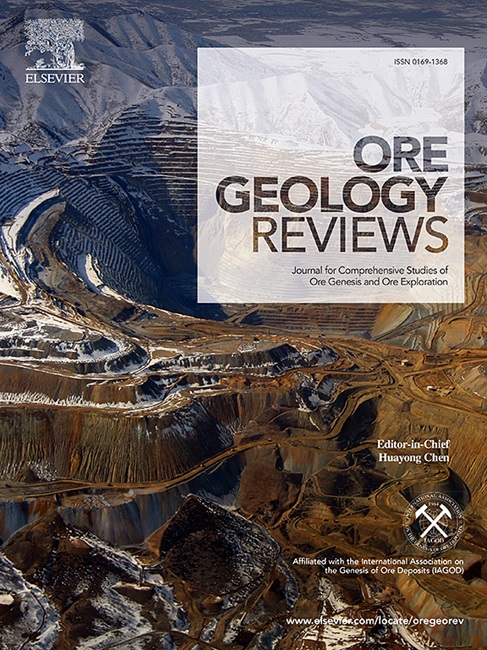Epidote geochemistry of the Chating porphyry Cu-Au deposit, eastern China: Metallogenic and exploration implications for porphyry Cu deposits associated with carbonate wall rocks
IF 3.2
2区 地球科学
Q1 GEOLOGY
引用次数: 0
Abstract
Epidote is one of the main alteration minerals in propylitic alteration, and its mineral chemistry has been shown to provide vectors to assist in exploration for hidden arc-related porphyry copper deposits hosted in volcanic rocks. However, it is unknown whether the same vectors are applicable in exploration for porphyry deposits hosted in carbonates. Chating copper–gold deposit in the Middle Lower Yangtze River Metallogenic Belt of eastern China is a porphyry deposit associated with limestone wall rocks. We systematically analyzed epidote associated with Chating deposit, using EMPA and laser ablation inductively coupled plasma mass spectrometry (LA-ICP-MS), to assess the factors controlling epidote geochemistry and the effectiveness of epidote chemistry as a vector in porphyry deposit which hosts in carbonates.
The petrographic study showed that there are three types of epidote in Chating: Ep1 (vein type), Ep2 (replacing magmatic minerals such as plagioclase and amphibole), and Ep3 (replacing skarn minerals such as garnet). All are hosted in the ore bearing quartz diorite porphyry. The major and trace element analysis results show that epidotes in Chating are enriched in Ca, Mn, Zn, Mg, P, Ti, Sr, As and Sb, with higher Ca and Al in Ep3 than in Ep1 and Ep2, and all epidotes are depleted in Cu, Au, Mo and Ag. Epidote chemistry in Chating varies with distance to the ore deposit center, with As, Sb, Pb, Ca and Al high distal from the deposit, whereas Fe, Sn and Fe/Al ratios are low. However, Mn, Zn, Cu and Au, which have proven to be effective vectors in subduction porphyry deposits, did not show systematic spatial variations. We suggest that epidote chemistry in Chating is controlled by several factors, including fluid composition, temperature, oxygen fugacity and the degree of fluid-rock interaction. The dominant factors that resulted in the restricted scale of propylitic alteration, and differences in the spatial trend of elements in epidote between Chating and subduction related porphyry deposits is the wall rock lithology and the degree of fluid-wall rock interaction. The spatial trends of As, Sb, Pb, Ca, Al, Fe, and Sn, and the content of Cu, Au and Mo in Chating epidote can also provide vectoring and fertility information, with potential to be applied in exploration for carbonate hosted porphyry deposits elsewhere.

中国东部茶亭斑岩型铜金矿床的绿石地球化学特征:与碳酸盐围岩伴生的斑岩型铜矿床成矿及找矿意义
绿帘石是丙基蚀变中的主要蚀变矿物之一,其矿物化学特征为火山岩中隐伏弧相关斑岩铜矿的找矿提供了载体。然而,同样的矢量是否适用于碳酸盐岩中的斑岩矿床的勘探尚不清楚。中国东部长江中下游成矿带茶亭铜金矿床是一个与灰岩围岩伴生的斑岩型矿床。利用EMPA和激光烧蚀电感耦合等离子体质谱(LA-ICP-MS)技术,系统分析了与Chating矿床相关的绿石,以评估控制绿石地球化学的因素,以及绿石化学作为碳酸盐中斑岩矿床载体的有效性。岩石学研究表明,茶亭绿帘石主要有3种类型:Ep1(脉型)、Ep2(替代斜长石、角闪洞等岩浆矿物)和Ep3(替代夕卡岩矿物石榴石等)。均赋存于含矿石英闪长斑岩中。主微量元素分析结果表明,茶亭绿帘石中Ca、Mn、Zn、Mg、P、Ti、Sr、As和Sb富集,Ep3中Ca和Al含量高于Ep1和Ep2, Cu、Au、Mo和Ag均富集。茶亭绿石的化学性质随离矿床中心的距离而变化,As、Sb、Pb、Ca和Al在离矿床中心较远的地方较高,而Fe、Sn和Fe/Al比值较低。而作为俯冲斑岩矿床有效载体的Mn、Zn、Cu和Au,在空间分布上没有系统的变化。认为茶亭绿帘石的化学性质受流体组成、温度、氧逸度和流体-岩石相互作用程度等因素的控制。导致茶亭斑岩与俯冲相关斑岩床丙质蚀变规模受限、绿帘石元素空间走向差异的主要因素是围岩岩性和流体-围岩相互作用程度。茶亭绿岩中As、Sb、Pb、Ca、Al、Fe、Sn的空间变化趋势以及Cu、Au、Mo的含量也可以提供矢量化和富性信息,具有在其他地区碳酸盐型斑岩矿床勘探中的应用潜力。
本文章由计算机程序翻译,如有差异,请以英文原文为准。
求助全文
约1分钟内获得全文
求助全文
来源期刊

Ore Geology Reviews
地学-地质学
CiteScore
6.50
自引率
27.30%
发文量
546
审稿时长
22.9 weeks
期刊介绍:
Ore Geology Reviews aims to familiarize all earth scientists with recent advances in a number of interconnected disciplines related to the study of, and search for, ore deposits. The reviews range from brief to longer contributions, but the journal preferentially publishes manuscripts that fill the niche between the commonly shorter journal articles and the comprehensive book coverages, and thus has a special appeal to many authors and readers.
 求助内容:
求助内容: 应助结果提醒方式:
应助结果提醒方式:


